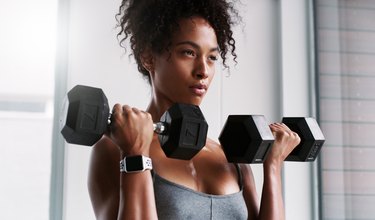
Biceps curls are an upper-body staple, but they also aren't the most exciting thing you can do with two dumbbells. So why not mix things up with the Zottman curl?
- What is a Zottman curl? It's a biceps curl variation that involves raising the weights up to your shoulder, then flipping the dumbbells so your palms face down and lowering from there.
- What muscles does it work? This move trains the long and short head of the biceps muscles, according to New York-based physical therapist and strength coach Sam Chan, DPT, CSCS. It also targets the brachialis and brachioradialis of your arm near your biceps. Lastly, it works both sides of your forearms and your grip strength.
- Who can do this curl? Most people can do the exercise without issue. But anyone with previous elbow or shoulder injuries (or pain) may want to confirm with a doctor that this move is safe — especially before using heavy weights.
- How does a Zottman curl compare to a hammer curl? They both work the front of your arms, just a little differently. By using a neutral (thumbs up) grip through the whole motion, the hammer focuses on the brachialis, which sits underneath your actual biceps. The Zottman, by transitioning between a pronated (overhand) and supinated (underhand) grip puts more emphasis on your biceps.
Video of the Day
How to Do the Zottman Curl With Perfect Form
Zottman Curl
- Stand with your feet hip-width apart, holding a dumbbell in each hand. Position your palms so they face forward.
- Keeping your elbow still, raise the weights up to your shoulders.
- Once you reach shoulder height, flip the weights so your palms face forward.
- With control, slowly lower the dumbbells back down to your sides.
Tip
Although specific set and rep ranges will vary according to personal fitness goals, most people tend to do curls for about 3 to 4 sets of 10 to 12 reps. Choose a set of weights that feels comfortably challenging. You should feel a little fatigued towards the end of your set, while still maintaining good form.
3 Zottman Curl Benefits
1. Increased Arm Strength
The biggest benefit of this exercise is increased all-around arm strength, according to Chan. As you bring the weights up, the exercise targets the two segments of your biceps (called the long and short head). As you rotate the weights, you work your forearm and wrists.
Then, on the way down, your flipped-hand position puts your biceps in a challenging position, he says. This targets your brachialis (the muscle along the inside of your elbow) and forearms.
2. Better Upper-Body Stability
Your shoulders are sensitive joints that are pretty injury-prone. And your biceps actually play a part in keeping them stable and injury-free, according to the American Academy of Orthopaedic Surgeons (AAOS). So doing curl variations like this one can help reduce your risk of aches and pains.
It can also help improve your core stability, according to Chan. When you raise the weights to your shoulders, your deep core muscles work to keep your back and pelvis upright. Focus on really bracing your core and not letting your torso sway.
3. Needed Variation
It's easy to think a biceps curl is a biceps curl, but switching things up with new variations every couple of months can make a big difference in your upper-body gains. When you hit a plateau with one, a change of grip positions can sometimes be just enough to get you progressing again.
2 Modifications to Make It Easier
Move 1: Hammer Reps
The hardest part of the exercise is the lowering or eccentric portion, Chan says. Instead of lowering the weights with your palms facing away from you, use a neutral grip (thumbs up) on the eccentric portion.
Move 2: Resistance-Band Reps
A resistance band Zottman curl is a good modification or alternative if you don't have dumbbells available, Chan says. The eccentric part of the exercise a little easier with a resistance band, too.
2 Progressions for an Added Challenge
Move 1: Eccentric Reps
When you lower the weights slowly, your muscles work longer and harder to stabilize the dumbbells, which means more strength gain, Chan says. Try an eccentric Zottman curl by lowering the weights over a 4- or 5-second count.
Move 2: Kneeling Reps
When do a kneeling Zottman curl, you can't use any momentum to raise the weights up to your shoulders, Chan explains. Expect an intense muscle burn.
Was this article helpful?
150 Characters Max
0/150
Thank you for sharing!
Thank you for your feedback!